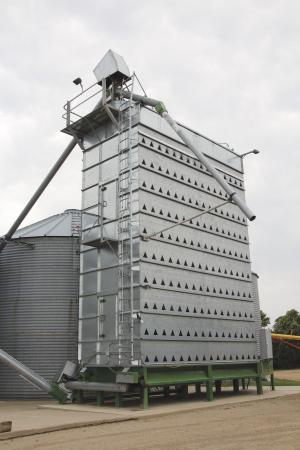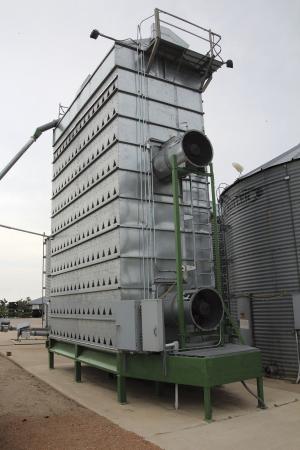2011 - Volume #35, Issue #5, Page #29
[ Sample Stories From This Issue | List of All Stories In This Issue | Print this story
| Read this issue]
Farm-Built Continuous Flow Grain Dryer
 |
 |
“I looked at a lot of different dryers and heard the same stories from all the salesmen,” Kelly says. “They promised a few things, fudged on a few others, and always came back with a hefty price tag. The more I looked at what was out there, the more confidence I had that I could build my own dryer and save money in the process.”
Kelly drew up a thorough set of plans and verified the design with friends in the construction business who knew engineering tolerances. He worked with a local welding shop to build the extra-sturdy main box frame. Then he integrated several used components from drying equipment suppliers, had a local manufacturing business build the drying chambers, and assembled it with the help of his son, who is a licensed electrician.
Kelly’s dryer has 3 custom-built chambers that dry grain quickly and efficiently, removing up to 5 percentage points of moisture from 875 bushels an hour. The control panel has built-in time delay switches so clutches will energize slowly and gradually bring the augers to speed. He built his own augers with an oversized main shaft and oversized flighting. The 8-in. augers run at 178 rpm’s and move as much corn as a 6-in. auger would at 440 rpm’s. “Moving grain slowly preserves the quality and reduces cracking,” Kelly says. “I’ve dried 32 percent corn and never had any problems.”
Kelly’s dryer has special fluted feed rolls built by a local business. They have a 90-degree twist so grain is lifted evenly and not forced against sidewalls where kernels could be crushed. As corn is dried, sensors trigger unloading and re-loading. If the dryer doesn’t have more wet corn coming in, another sensor reduces heat in the drying units and gradually shuts them down.
Kelly built a gas injection system that adjusts pressure to compensate for ambient air temperature. “If the outside air temperature is warm, the gas flow pinches down and I don’t use as much gas,” Kelly says, “and that saves money on fuel.” Buying a factory-made sensor would have cost $1,600 to $1,800, but Kelly’s system was less than a hundred dollars.
Kelly is a strong believer in “steeping” his grain rather than drying it to 13 percentage moisture in the dryer. He puts 16 percent moisture warm corn in the storage bin where he aerates it with ambient air. “I’ve never had spoiled corn with this system and I’ve been doing it this way for 10 years,” Kelly says.
Building the dryer was a year-long project and Kelly figured his cost was less than half what he would have paid for a similar sized commercial dryer. “The toughest part was putting 23,000 nuts and bolts in the drying chambers,” Kelly says. “If we add two more chambers on this unit, which it’s set up to handle, I’m going to make sure we use rivets instead of bolts.”
Contact: FARM SHOW Followup, Tim Kelly, 74861 262nd St., Dassel, Minn. 55325 (ph 320 286-2371).

Click here to download page story appeared in.

Click here to read entire issue
To read the rest of this story, download this issue below or click here to register with your account number.




